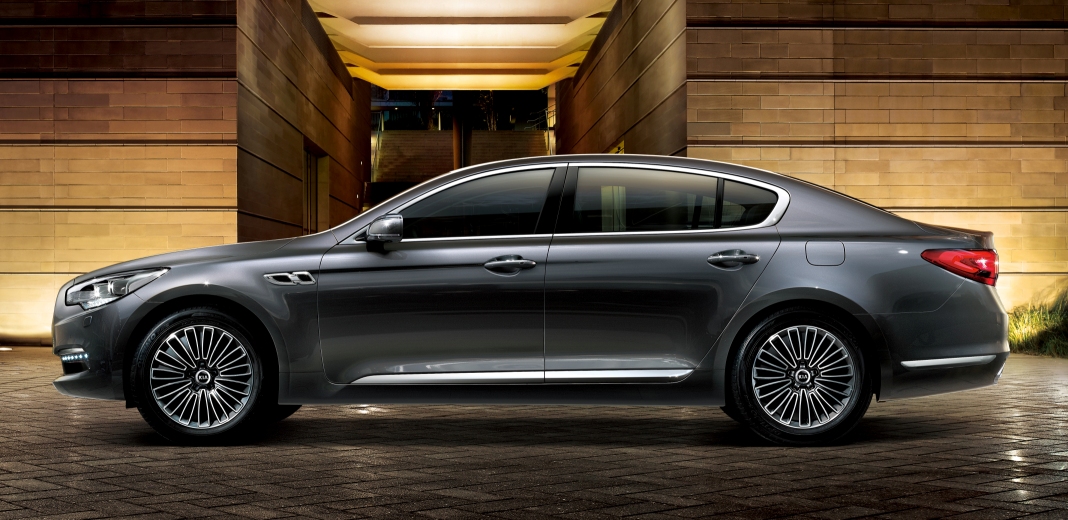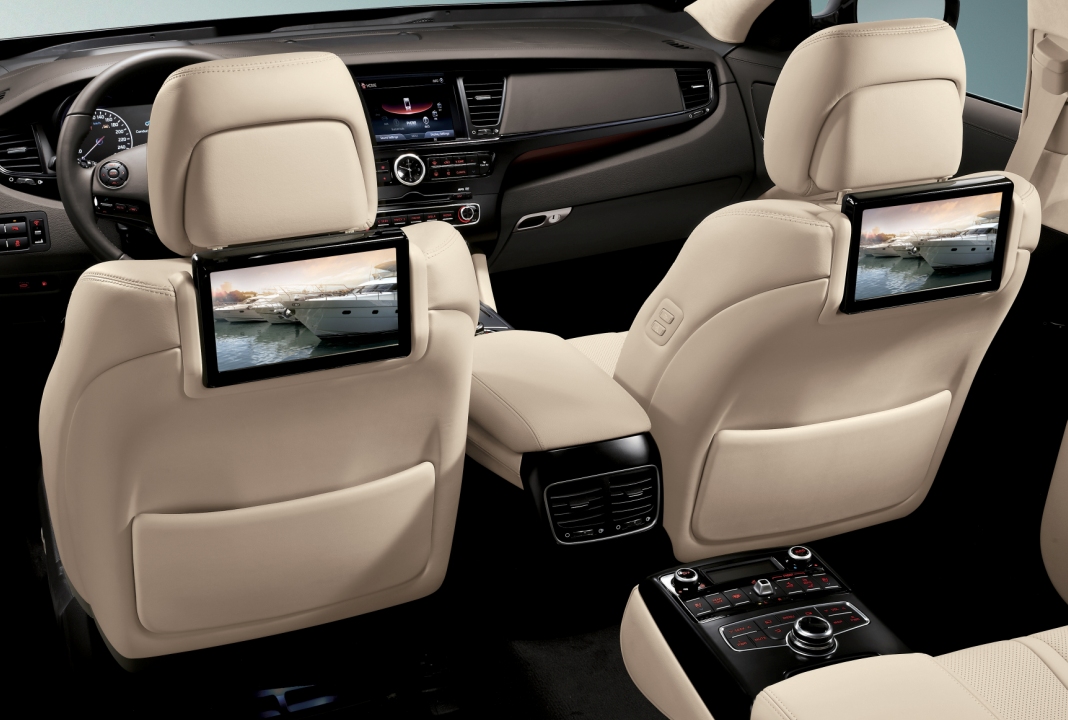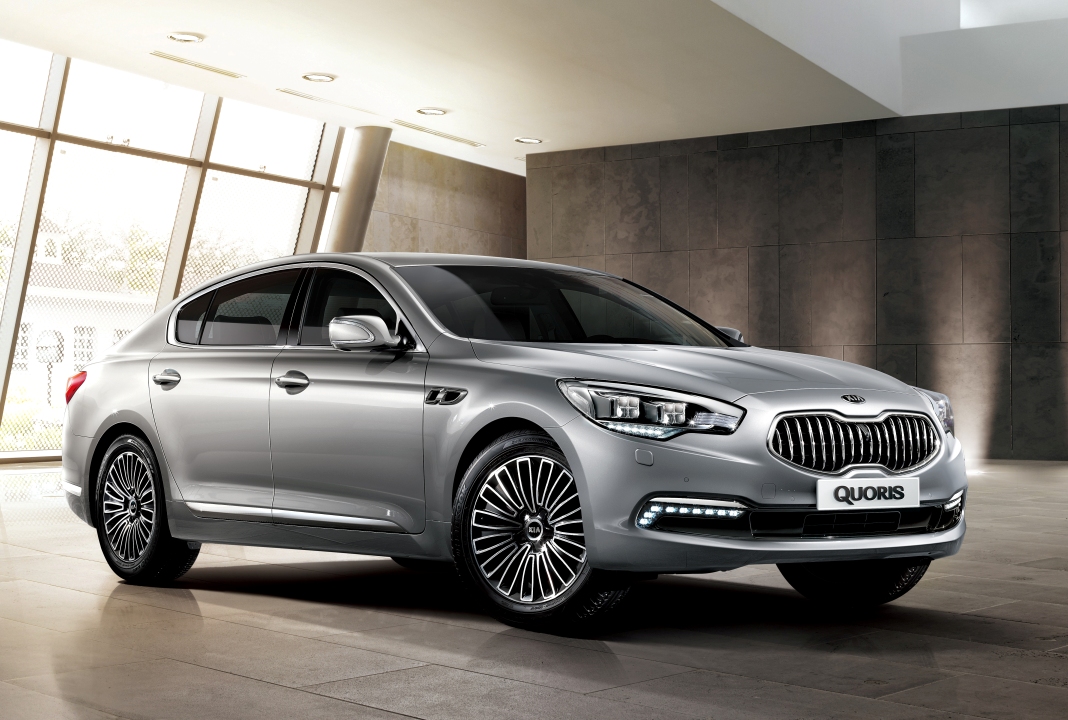A world-class luxury car based on the same platform that underpins Hyundai’s acclaimed Centennial and Genesis models. Distinctly sportier-looking than its Hyundai cousins, the Kia Quoris features cutting edge design, high tech features and systems and a tastefully plush interior. Sized as a luxury car, the Quoris is however being also pitched as a better equipped alternative to European executive cars.
Called the K9 in its home market, one might quibble that the Quoris’ creative name – derived from ‘core’ and ‘quality’ – could take time getting used to, but its smart design is one that is sophisticated but instantly accessible. With hints of contemporary BMW, Maserati and Jaguar about it, the Quoris however has a distinct sense of style relating to Kia’s contemporary Peter Schreyer designed line-up. A vast luxury car, the Quoris’ tight and flowing design lines and sharp attention to detail packages its 5090mm length and 1910kg weight well, with dynamically tense lines and proportions lending it an elegant sense of athleticism.
 With its sharp all-LED headlights, short front overhang, aggressive ‘Tiger’ corporate grille design and muscular and ridged bonnet, the Quoris has an assertive presence. Riding on discrete and elegant alloy wheels somewhat reminiscent of the DeLorean DMC-12, the Quoris’ large and muscular wheel-arches could easily accommodate sportier looking footwear, but at 245/50R18, it strikes the right balance between comfort and style. From side views the Quoris’s long bonnet and rakishly arced roofline are complemented by a strong sill line and side ports, from which an elegant character line extends and lends a sense of motion. Converging at the rear are the Quoris’ low roof, prominent haunches and a high rear boot.
With its sharp all-LED headlights, short front overhang, aggressive ‘Tiger’ corporate grille design and muscular and ridged bonnet, the Quoris has an assertive presence. Riding on discrete and elegant alloy wheels somewhat reminiscent of the DeLorean DMC-12, the Quoris’ large and muscular wheel-arches could easily accommodate sportier looking footwear, but at 245/50R18, it strikes the right balance between comfort and style. From side views the Quoris’s long bonnet and rakishly arced roofline are complemented by a strong sill line and side ports, from which an elegant character line extends and lends a sense of motion. Converging at the rear are the Quoris’ low roof, prominent haunches and a high rear boot.
Offered with a choice of two engines for the Korean domestic market, the K9 version gets a choice of modern and more efficient 296BHP 3.3-litre or 329BHP 3.8-litre direct injection V6 engines, while initially Quoris versions bound for ‘general markets’ will receive a more conventional multi-point fuel injection version of the 3.8, developing 294BHP at 6,000rpm and 264lb/ft at 45,00rpm. Mated to a very smooth shifting 8-speed automatic gearbox, the Quoris’s 3.8-litre engine is whisper quite at high speed and great cabin isolation ensures serenity at all times. The 8-speed gearbox also makes the best use of all 294 ponies in terms of performance and efficiency.
 A smooth and intuitive gearbox, the Quoris 8-speed can be set in sport mode where its shifts are biased for performance rather than economy, while manual mode maintains the smoothness, along with a greater sense of control, with one actuating shifts through the gear lever. A somewhat high revving engine, the Quoris 3.8 however enjoys good mid-range ability, which with the greater number of ratios returns confident on-the-move performance, 0-100km/h acceleration in just 7.3-seconds and 240km/h maximum despite a hefty 1.9-ton weight. Returning a 10.4l/100km combing fuel efficiency rating and 248g/km CO2 emissions, the MPI version isn’t far behind the direct injection version. The Quoris is expected to be offered in future with s turbocharged four-cylinder engine, and probably a V8 for US buyers.
A smooth and intuitive gearbox, the Quoris 8-speed can be set in sport mode where its shifts are biased for performance rather than economy, while manual mode maintains the smoothness, along with a greater sense of control, with one actuating shifts through the gear lever. A somewhat high revving engine, the Quoris 3.8 however enjoys good mid-range ability, which with the greater number of ratios returns confident on-the-move performance, 0-100km/h acceleration in just 7.3-seconds and 240km/h maximum despite a hefty 1.9-ton weight. Returning a 10.4l/100km combing fuel efficiency rating and 248g/km CO2 emissions, the MPI version isn’t far behind the direct injection version. The Quoris is expected to be offered in future with s turbocharged four-cylinder engine, and probably a V8 for US buyers.
With much emphasis placed on comfort and composure, the Kia Quoris delivers a smooth and supple ride quality that almost wafts over and irons out road imperfections and leaving its occupants unruffled. Highly insulated for noise, vibration and harshness, the Quoris cabin refinement is complemented by its adaptive multi-link air suspension. Undoubtedly comfort-oriented, the Kia Quoris however manages this with being completely aloof, vague or disconnected, but in fact maintains a natural sense of balance, and just enough feedback for its quick and light steering to keep its intuitive and interesting through winding roads.
 Very stable, smooth, supple and comfortable at high speed or on winding roads but with decent chassis balance and handling ability underneath, the Kia Quoris is as a luxury car should be, and not an uncomfortably firm pseudo-sports sedan. Easy to place on the road for its size, the Quoris’ long wheelbase, short overhangs, near ideal weight distribution and steering and suspension set-ups make it easy and willing to turn-in smartly into a corner. Featuring adaptive suspension that tightens for corners, and a firmer sport setting for better body control, the Quoris’s slight body roll is on the soft but progressive, controlled and natural side, and well complements its high lateral grip.
Very stable, smooth, supple and comfortable at high speed or on winding roads but with decent chassis balance and handling ability underneath, the Kia Quoris is as a luxury car should be, and not an uncomfortably firm pseudo-sports sedan. Easy to place on the road for its size, the Quoris’ long wheelbase, short overhangs, near ideal weight distribution and steering and suspension set-ups make it easy and willing to turn-in smartly into a corner. Featuring adaptive suspension that tightens for corners, and a firmer sport setting for better body control, the Quoris’s slight body roll is on the soft but progressive, controlled and natural side, and well complements its high lateral grip.
Balanced and intuitive on country roads, the Quoris is one of few luxury cars that seem to strike a harmonious chord between supple soft comfort and handling. Stable and confident, the Quris can also float through winding roads with a sense of natural handling talent, buttoned down manners and willingness to be hustled, undernesth its layers of refinement. The Quoris’ big brakes are also effective, but require long pedal travel for sudden full power braking. The Quoris’ stability controls are however over-eager in default mode, and seem to preempt grip loss, particularly if the front wheels drive over a sudden mid-corner crack or even a metal linkage in the road for which there is enough natural grip.
 Awash with high quality materials, the Kia Quoris’ interior has a plush, airy and welcoming, yet unpretentious ambiance, with wonderfully comfort seats perfect for long journeys. Plastics used for the Quoris’ dashboard are soft touch textures, metallic inserts were tasteful, leather bound steering and seats are of high quality, while the suede-like roof lining was particularly nice. Hugely comfortable the Quoris also enjoys excellent rear legroom and width. Spacious in almost every which way, one felt that the Quoris’ seats could have been set slightly lower to balance its rakish roofline and provide more generous head room for taller occupants, on par with its legroom.
Awash with high quality materials, the Kia Quoris’ interior has a plush, airy and welcoming, yet unpretentious ambiance, with wonderfully comfort seats perfect for long journeys. Plastics used for the Quoris’ dashboard are soft touch textures, metallic inserts were tasteful, leather bound steering and seats are of high quality, while the suede-like roof lining was particularly nice. Hugely comfortable the Quoris also enjoys excellent rear legroom and width. Spacious in almost every which way, one felt that the Quoris’ seats could have been set slightly lower to balance its rakish roofline and provide more generous head room for taller occupants, on par with its legroom.
With clear instrumentation, plenty of storage space, intuitive controls and a long list of standard and optional equipment, the Kia Quoris’ interior is a busy but pleasant environment with lots of buttons on the dashboard, doors, and consoles – including a huge multi-function rear console, which includes infotainment, climate and seat reclining and temperature controls. Well equipped, the Quoris comes with electric everything, four zone climate control, rear DVD screens and a superb sound system. High tech safety systems include radar-based adaptive cruise control and blind spot and lane departure warning systems, and adaptive lights, while brakes are automatically primed if a potential collision is detected.
 Specifications: Kia Quoris 3.8 MPI
Specifications: Kia Quoris 3.8 MPI
- Engine: 3.8-litre, in-line V6-cylinders
- Bore x stroke: 96 x 87mm
- Compression: 11.5:1
- Valve-train: 24-valve, dual continuously variable valve timing
- Gearbox: 8-speed auto, rear-wheel-drive
- Ratios: 1st 3.665; 2nd 2.396; 3rd 1.61; 4th 1.19; 5th 1.0; 6th 0.826; 7th 0.643; 8th 0.556
- Reverse / final drive ratios: 2.273 / 3.909
- Power, PS (BHP) [kW]: 294 (290) [216] @ 6,000rpm
- Torque, lb/ft (Nm): 264 (358) @ 4,500rpm
- 0-100km/h: approximately 7.3-seconds
- Top speed: 240km/h
- Fuel consumption, combined: 10.4-litres/100km
- CO2 emissions: 248g/km
- Length: 5,090mm
- Width: 1,900mm
- Height: 1,490mm
- Wheelbase: 3,045mm
- Track, F/R: 1,616/1,634mm
- Overhang, F/R: 875/1,170mm
- Ground clearance: 150mm
- Aerodynamic drag co-efficient: 0.27
- Headroom, F/R: 1,020/964mm
- Legroom, F/R: 1,145/990mm
- Shoulder-room, F/R: 1,500/1,452mm
- Hip-room, F/R: 1,419/1,416mm
- Luggage volume: 455-litres
- Fuel capacity: 75-litres
- Kerb weight: 1930kg
- Steering: Electro-hydraulic assisted rack & pinion
- Lock-to-lock: 2.81 turns
- Turning Circle: 12.08-meters
- Suspension, F/R: Multi-link, air damping, coil springs, anti-roll bars
- Brakes, F/R: 320 x 28mm ventilated disc / 314 x 13mm disc
- Stopping distance, 100-0km/h: 43.2-meters
- Tires: 245/50R18





























Recent Comments